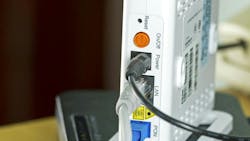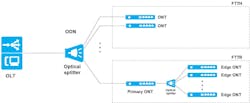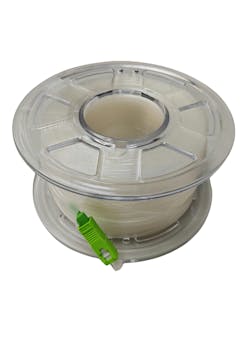Fiber to the Room (FTTR): A Solution for Indoor Connectivity
Demands for high bandwidth, high bit rates in both directions, low latency, and service reliability are constantly growing. Applications such as online learning, remote work, online gaming, video conferencing, live video streaming, IoT, virtual and augmented reality, and others are widely used. The issues with internet service became especially evident during the corona virus pandemic, when people spent most of their time at home, working remotely, with children studying from home, and so on. This period highlighted the real need for reliable, high-performance services.
Problems with WiFi Networks
WiFi has become the predominant network for both residential and many business users. There is hardly a person with internet service who does not use WiFi. Devices supporting the WiFi standard are ubiquitous, including laptops, smart phones, tablets, printers, and more. Alongside demands for high bandwidth, high bit rates, and low latency, WiFi networks also require good coverage, the capacity to support a large number of simultaneous users, and robust security.
However, there are inherent challenges in using WiFi networks that are difficult to overcome. The intensity of WiFi signals, like any other signal, diminishes as they propagate. Furthermore, numerous obstacles cause additional signal attenuation, such as walls, furniture, doors, windows, and other physical barriers. Metal objects completely reflect signals, while water absorbs them. Additionally, many devices operate on the same or nearly identical frequency bands, introducing interference. Examples include neighboring WiFi devices, microwave ovens, refrigerators, older cordless phones, baby monitors, drones, and Bluetooth devices (headphones, keyboards, mice, watches, etc.).
This interference and signal attenuation are particularly problematic in larger apartments, houses, offices, or cottages.
Problems with WiFi networks can be mitigated in several ways. Among these, the following solutions should be emphasized:
· Determining an optimal location for the WiFi device (ONT, modem, or router). It should ensure adequate coverage of the apartment, be positioned as far as possible from electrical devices, and should not be placed on the floor, near walls, or inside an enclosure.
· Changing the WiFi channel – WiFi devices offer options to automatically or manually change channels in case of interference.
· Using 5 GHz instead of 2.4 GHz, as interference predominantly affects the 2.4 GHz frequency.
· Investing in a high-quality WiFi device – some devices reduce interference by using advanced technologies like beamforming to direct the signal toward user devices.
To address challenges related to higher coverage and bit rates, the following steps are required:
· Optimizing the position of the WiFi device for better signal distribution.
· Adding additional WiFi devices, such as repeaters or mesh network systems, to ensure comprehensive coverage of the apartment.
· Automatic or manual channel selection and expanding the channel bandwidth used by the WiFi device.
· Switching to 5 GHz for higher bandwidth and speeds, acknowledging that the higher frequency has a shorter range.
· Updating the WiFi device’s software, which can resolve certain issues and enhance overall performance.
· Upgrading to a modern WiFi device equipped with advanced features like beamforming and MU-MIMO (Multi-User, Multiple Input, Multiple Output).
In general, most of these problems and solutions are already well-known to many. We are fighting using all of this, but still, we are unable to provide what we desire. There are also issues that haven't been discussed until now, particularly problems with the fixed access network, especially its last segment. If we use an HFC (Hybrid Fiber Coaxial) network from a cable operator or DSL (Digital Subscriber Line) technology from Telekom over copper pairs, we can constantly expect service issues. Even FTTH PON (Fiber To The Home Passive Optical Network) cannot meet all the demands of today's user, especially with WiFi networks.
The question then arises: what is the solution? The solution is FTTR (Fiber To The Room).
FTTR
The currently most well-known and reliable fixed access network in use is FTTH PON. It is a completely passive optical network, where active components are only located in the CO (Central Office)/HE (Head End) and at the subscriber's homes/offices. FTTH PON is a P2MP (Point to Multi-Point) optical network, where each fiber is shared by a large number of users. For this purpose, bidirectional optical splitters are used, and the number of splits mostly depends on the distance to the subscriber and the PON standard. Fibers are typically split into 32, 64, or 128.
The optical fiber cable of the PON network enters the office, apartment, or house of the subscriber, enabling all the advantages of the optical network. However, problems with WiFi networks are still present. Introducing solutions where WiFi devices are wirelessly connected to each other is not reliable enough. To solve these problems, the FTTR solution has been introduced.
The architecture of the FTTR solution includes one main ONT and several edge ONTs, all interconnected via optical cables.
The main ONT serves as the core element of the FTTR solution, where the drop optical cable terminates (directly or via an ATB (Access Terminal Box). In addition to a standard input optical port, the main ONT features an output optical port. Edge ONTs are connected to this output port through an optical splitter. Furthermore, the main ONT includes standard GE and POTS interfaces and supports the WiFi standard.
The edge ONTs are placed in various rooms or offices to provide a reliable WiFi network. Like the primary ONT, these units are equipped with standard GE and POTS interfaces and support the WiFi standard.
To connect the main ONT and the edge ONTs, FTTR FDU (Fiber Distribution Unit) for residential users or FTTR ADU (Active Distribution Unit) for business users is employed. These are essentially plastic enclosures housing an optical splitter. This setup allows for the connection of up to 16 ONTs for residential users and up to 32 ONTs for business users. Transparent or invisible drop optical cables with a single fiber are used for connectivity, featuring XC/UPC connectors at both ends (pre-terminated solution). The most common standards for these cables are G.657.A2 and G.657.B3. To secure these cables, a specialized adhesive tool is used specifically for this purpose.
There is a small difference between the FTTR solution for residential and business users. In addition to the difference in the models of primary and edge ONTs, there is also a difference in passive optical components such as FTTR ADUs and optical cables. The FTTR ADU allows the connection of a larger number of edge ONTs, up to 32. Secondly, small and medium-sized businesses often use devices that require remote power via the PoE (Power over Ethernet) standard, which is why pre-terminated hybrid optical cables are used.
The Most Important Features of the FTTR Solution
FTTR ensures reliable services throughout homes, apartments, or offices. Its most important features include:
· Reliable and invisible connections between ONT devices. The optical connection between devices ensures a reliable and high-quality link compared to wireless or traditional wired solutions (e.g. UTP cables). Additionally, the use of transparent cables and a simple and reliable installation method is extremely important, as subscribers do not want new cables, drilling, channels, etc. People are very sensitive about this, and any other solution would present a significant problem.
· High-quality and reliable WiFi network. With optimal placement of ONTs in the house, apartment, or offices, complete WiFi coverage is ensured, with high bandwidth, high bit rates in both directions (WiFi 6, frequency range of 160 MHz, enabling bit rates up to 1.2 Gbps or even 2 Gbps), latency <1 ms, jitter <1%, reduced interference, the ability to connect a large number of devices simultaneously (64 devices connected in parallel to each ONT, or a maximum of 100 devices on the WiFi network), and constant roaming (seamless transition of the subscriber from one ONT to another in <50 ms). All ONTs support BandSteering and have the same SSID for both frequency ranges.
· Simple management, monitoring, and real-time troubleshooting at the home network level. This is achieved using different software tools, reducing the need for technicians to visit subscribers and improving the user experience.
· Optimized performance of all ONTs. Power consumption is reduced by 30% compared to standard solutions. ONTs recognize more demanding services, such as online learning, online gaming, etc., and prioritize them over other applications (reducing latency and packet loss, thereby improving the user experience).
· Support for the PoE standard. This option is particularly important for business users who have devices that require remote power, such as APs, IP cameras, and others.
Conclusion
The FTTR solution has wide applications in houses, villas, small buildings, restaurants, hospitals, small and medium-sized businesses, etc. By implementing this solution, we achieve a highly reliable optical and Wi-Fi network that provides all existing and future services.
About the Author

Vladimir Grozdanovic
Vladimir Grozdanovic is a graduate electrical engineer for telecommunications with more than 10 years of experience in access networks (HFC and FTTH) in large cable operators in Serbia (SBB and Jotel). He has many international certificates (FOA and Huawei) for optical networks. Vladimir is also the author of the book FTTx: Practical Guide for Designing, Building, and Maintaining FTTx Networks in Serbian. He frequently writes articles about optical networks for the Serbian magazine Glasnik and the American FOA Newsletter.



